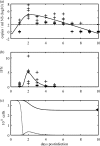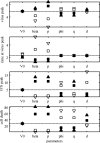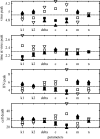Dynamics of influenza virus infection and pathology
- PMID: 20130053
- PMCID: PMC2849502
- DOI: 10.1128/JVI.02078-09
Dynamics of influenza virus infection and pathology
Abstract
A key question in pandemic influenza is the relative roles of innate immunity and target cell depletion in limiting primary infection and modulating pathology. Here, we model these interactions using detailed data from equine influenza virus infection, combining viral and immune (type I interferon) kinetics with estimates of cell depletion. The resulting dynamics indicate a powerful role for innate immunity in controlling the rapid peak in virus shedding. As a corollary, cells are much less depleted than suggested by a model of human influenza based only on virus-shedding data. We then explore how differences in the influence of viral proteins on interferon kinetics can account for the observed spectrum of virus shedding, immune response, and influenza pathology. In particular, induction of high levels of interferon ("cytokine storms"), coupled with evasion of its effects, could lead to severe pathology, as hypothesized for some fatal cases of influenza.
Figures









Similar articles
-
Modeling within-host dynamics of influenza virus infection including immune responses.PLoS Comput Biol. 2012;8(6):e1002588. doi: 10.1371/journal.pcbi.1002588. Epub 2012 Jun 28. PLoS Comput Biol. 2012. PMID: 22761567 Free PMC article.
-
Evolution of equine influenza virus in vaccinated horses.J Virol. 2013 Apr;87(8):4768-71. doi: 10.1128/JVI.03379-12. Epub 2013 Feb 6. J Virol. 2013. PMID: 23388708 Free PMC article.
-
Longitudinal study describing the clinical signs observed in horses naturally infected with equine influenza.Aust Vet J. 2011 Jul;89 Suppl 1:22-3. doi: 10.1111/j.1751-0813.2011.00733.x. Aust Vet J. 2011. PMID: 21711276
-
Whole inactivated equine influenza vaccine: Efficacy against a representative clade 2 equine influenza virus, IFNgamma synthesis and duration of humoral immunity.Vet Microbiol. 2013 Mar 23;162(2-4):396-407. doi: 10.1016/j.vetmic.2012.10.019. Epub 2012 Oct 24. Vet Microbiol. 2013. PMID: 23146168
-
A Brief Introduction to Equine Influenza and Equine Influenza Viruses.Methods Mol Biol. 2020;2123:355-360. doi: 10.1007/978-1-0716-0346-8_26. Methods Mol Biol. 2020. PMID: 32170701 Review.
Cited by
-
In-host Mathematical Modelling of COVID-19 in Humans.Annu Rev Control. 2020;50:448-456. doi: 10.1016/j.arcontrol.2020.09.006. Epub 2020 Sep 30. Annu Rev Control. 2020. PMID: 33020692 Free PMC article.
-
Quantifying Immune Response to Influenza Virus Infection via Multivariate Nonlinear ODE Models with Partially Observed State Variables and Time-Varying Parameters.Stat Biosci. 2015 May 1;7(1):147-166. doi: 10.1007/s12561-014-9108-2. Stat Biosci. 2015. PMID: 26085850 Free PMC article.
-
The continual threat of influenza virus infections at the human-animal interface: What is new from a one health perspective?Evol Med Public Health. 2018 Sep 7;2018(1):192-198. doi: 10.1093/emph/eoy013. eCollection 2018. Evol Med Public Health. 2018. PMID: 30210800 Free PMC article. Review.
-
Host-pathogen kinetics during influenza infection and coinfection: insights from predictive modeling.Immunol Rev. 2018 Sep;285(1):97-112. doi: 10.1111/imr.12692. Immunol Rev. 2018. PMID: 30129197 Free PMC article. Review.
-
Sequential infection experiments for quantifying innate and adaptive immunity during influenza infection.PLoS Comput Biol. 2019 Jan 17;15(1):e1006568. doi: 10.1371/journal.pcbi.1006568. eCollection 2019 Jan. PLoS Comput Biol. 2019. PMID: 30653522 Free PMC article.
References
-
- Ada, G. L., and P. D. Jones. 1986. The immune response to influenza infection. Curr. Top. Microbiol. Immunol. 128:1-54. - PubMed
-
- Beauchemin, C., J. Samuel, and J. Tuszynski. 2005. A simple cellular automaton model for influenza A viral infections. J. Theor. Biol. 232:223-234. - PubMed
-
- Bocharov, G. A., and A. A. Romanyukha. 1994. Mathematical model of antiviral immune response. III. Influenza A virus infection. J. Theor. Biol. 167:323-360. - PubMed
Publication types
MeSH terms
Substances
Grants and funding
LinkOut - more resources
Full Text Sources
Research Materials

